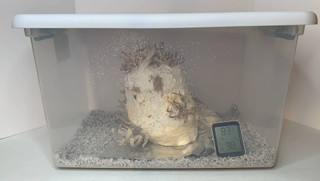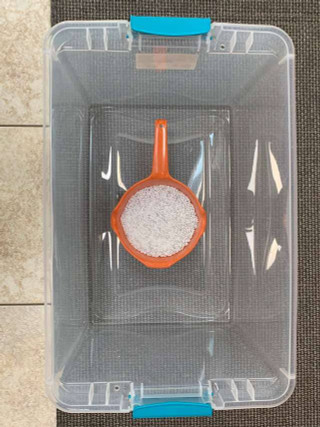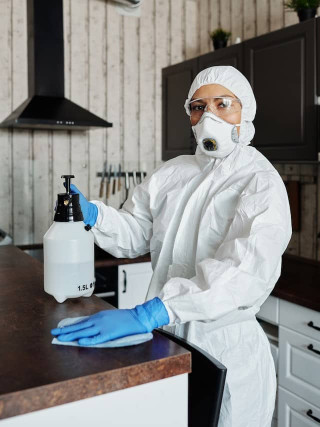Shotgun Fruiting Chambers (SGFC): How to Build One and Do They Work?
Posted by Troy Cosky, Founder FunGuy Grow Supply on 3rd Jun 2023

Introduction to Mushroom Cultivation with a Shotgun Fruiting Chamber (SGFC)
Are you interested in growing your own mushrooms? Mushroom cultivation can be a fun and rewarding hobby that provides you with fresh, delicious fungi for cooking or eating. However, to successfully grow mushrooms, you need to create the right environment for them to thrive. That's where a shotgun fruiting chamber (SGFC) comes in. An SGFC is a cost-effective and popular DIY fruiting chamber used by mushroom growers, particularly those using the PF Tek method, to provide an optimal environment for their fungi.
Building an SGFC may seem daunting at first, but it's actually quite simple. In just five easy steps, you can have a functional fruiting chamber that will help your mushrooms grow healthy and strong. This article will guide you through the process of building an SGFC from start to finish, providing helpful tips and resources along the way.
As you move forward in learning about mushroom cultivation, remember that patience is key when it comes to growing fungi. It takes time and effort to create healthy mycelium cultures and ultimately produce fruitful yields of edible mushrooms. By building an SGFC using these simple instructions as a starting point and continuing to educate yourself on best practices for mushroom cultivation, you'll be well on your way toward success in this exciting hobby!
Essential Knowledge for Successful Mushroom Growing in an SGFC
To cultivate mushrooms successfully, it's crucial to comprehend their life cycle and specific environmental requirements for growth. Mushrooms are a type of fungus that grows in damp and dark places. They start as spores and develop into mycelium, which is the vegetative part of the fungus. Mycelium eventually forms fruiting bodies that we know as mushrooms.

To grow mushrooms, you need to create an environment that mimics their natural habitat. This means keeping the air moist, providing indirect light, and ensuring fresh air exchange. One way to achieve this is by building a shotgun terrarium or DIY mushroom fruiting chamber also known as SGFC tek or fruiting chamber for mushrooms.
A DIY mushroom growing kit can be used instead of building your chamber from scratch. Whichever method you choose to use, it's important to maintain proper humidity levels within the enclosure using misters or humidifiers. The temperature should also be kept between 65-75 degrees Fahrenheit for optimal growth.
Understanding mushroom cultivation requires attention to detail and patience as it can take several weeks before any signs of growth appear. But with proper care and maintenance of your SGFC or DIY mushroom growing kit, you'll soon have a successful harvest that will satisfy your taste buds and bring joy to your gardening experience.
Now that you understand the basics of mushroom cultivation, let's move on to the materials and equipment needed for creating your very own SGFC without breaking the bank!
Materials and Equipment Needed for Building an SGFC
You may already have most of the materials and equipment needed for constructing your mushroom fruiting enclosure, which can be a cost-effective way to start cultivating your very own mushrooms at home. To set up your DIY mushroom grow box, you'll need a clear plastic tote that's 14 inches high and 12 inches wide, coarse perlite as the substrate, and a power drill with a ¼” bit to create air holes in the container.

In addition to these primary materials, you'll also need other tools like a spray bottle for misting water inside the grow chamber and a measuring tape to ensure accurate hole placement. It's important to wear gloves when handling perlite since it's dusty and can cause irritation if inhaled or touched by bare hands.
The shotgun fruiting chamber tek requires that you maintain specific conditions of humidity (85-95%) and temperature (68-78°F) within the chamber for optimal growth.
To help make things easier for you, here are two nested bullet point lists:
- Clear plastic tote
- Coarse perlite
- Power drill with ¼” bit
- Spray bottle
- Measuring tape
- Gloves
- Dust mask (optional)
- Marker or pencil
Materials:
Equipment:
By having all these items on hand before starting construction, you'll be able to save time and effort during setup. With this knowledge about materials and equipment covered, let's move on to building your sgfc without any unnecessary delays.
Step-by-Step Guide to Build A Shotgun Fruiting Chamber
Now that you've gathered all the necessary materials and equipment, it's time to construct your very own mushroom fruiting enclosure using a clear plastic tote, perlite, and a power drill with a ¼” bit for creating air holes. This is known as a shotgun fruiting chamber (SGFC) or the shotgun terrarium tek. It's one of the simplest and most effective methods of growing mushrooms at home.

To begin building your SGFC, mark out evenly spaced holes on all 6 sides of the tote, including the lid and bottom. Make sure to leave enough space between each hole so that there's adequate airflow without compromising humidity levels. Once you've marked out where you want to drill your holes, use your power drill to create them. These holes on all sides help maintain an ideal balance of fresh air and humidity inside your mushroom fruiting chamber.
Next, pour about 10-12cm deep layer of perlite into the bottom of the tote. Ensure that the perlite is soaked with water to create a humid environment for mushroom growth. The transparency of the plastic container allows natural light in while still accommodating headspace for mushroom growth.
After preparing your SGFC by filling it with damp perlite, it's time to place your mushroom blocks or colonized substrate into it. Position your SGFC in an elevated location to allow optimal airflow around it. Ideally, it should be placed in a location with indirect natural light though artificial light can work if timed similarly to mimic natural light cycles.
Constructing an SGFC is relatively easy once you have all the necessary materials and equipment at hand. With just a clear plastic tote, perlite layering technique along with drilled holes creating air flow circulation around this DIY mushroom grow box becomes possible effortlessly! However, before moving on, maintaining such a setup requires some maintenance which we will discuss in detail in our next section - ‘The Importance of Regularly Maintaining Your Mushroom Fruiting Chamber'.
The Importance of Regularly Maintaining Your Mushroom Fruiting Chamber
Ready for a thriving mushroom crop? Let's dive into the crucial upkeep required to maintain your DIY fruiting enclosure.

The shotgun fruiting chamber, or SGFC, needs regular attention to ensure optimal growing conditions for your mushrooms. First and foremost, maintaining humidity levels is essential. Mist your chamber twice daily with clean water to keep humidity levels around 90%. This will help prevent wilting or cracking of the mushrooms.
Temperature control is also important when it comes to maintaining your SGFC. Keep an eye on the temperature using a thermometer and make sure it stays within the ideal range for your specific type of mushroom. Most varieties prefer temperatures between 68-78°F (20-25°C). It's best to avoid drastic fluctuations in temperature as this can cause stress and hinder growth.
In addition to monitoring humidity and temperature, proper airflow is necessary for healthy mushroom growth. Fanning twice daily helps circulate fresh air throughout the grow chamber which prevents stale air from accumulating. Stale air leads to increased CO2 levels which can stunt growth or even kill off your precious crop.
Regular maintenance and monitoring of your SGFC are essential components of successful mushroom cultivation. By consistently misting, checking temperature, and fanning twice daily, you'll be well on your way to a bountiful harvest!
In our next section about enhancing SGFC efficiency, we'll explore additional tips that can help take your growing game up to another level!
Step Up Your SGFC with the Best Humidifiers!
Achieving the ideal conditions in your SGFC or indoor greenhouse starts with the right humidifier. Whether you're using SGFC's or advanced equipment, our guide reveals the top humidifier choices for optimal growth conditions. Click here to learn which humidifier complements your setup best!
Enhancing SGFC Efficiency for Increased Mushroom Yield
If you want to maximize your mushroom yield, it's worth exploring techniques like double-end casing and adapting your SGFC for bulk substrates or monotub use - but first, let's dive into enhancing the efficiency of your fruiting enclosure! Here are some tips to help you get the most out of your shotgun fruiting chamber (SGFC):

- Monitor humidity levels: The ideal range for growing mushrooms is between 80-90% humidity. Make sure to keep a hygrometer inside your SGFC to ensure that the humidity stays within this range. If it drops too low, mist the walls of the chamber with water until it rises back up.
- Maintain consistent temperature: Mushrooms grow best at temperatures between 65-75°F. Keep your SGFC in a room with a stable temperature and avoid placing it near windows or doors where drafts can cause fluctuations.
- Use proper lighting: While mushrooms don't need light to grow, they do need a light cycle to trigger fruiting. A 12-hour light/dark cycle is recommended for most species. You can use inexpensive LED strip lights or fluorescent bulbs placed on top of your SGFC.
- Increase airflow: Good air exchange helps prevent contamination and encourages healthy growth. One way to enhance airflow is by adding more ventilation holes to the sides of your SGFC using a drill or hole saw.
By following these tips, you can ensure that your SGFC is functioning at its highest efficiency and providing optimal conditions for mushroom growth.
In the next section, we'll explore some species-specific guidelines for growing different types of mushrooms.
As you move on to learning about species-specific guidelines for growing mushrooms efficiently in an SGFC, remember that maintaining proper humidity levels and temperature while also increasing airflow will continue to be key factors in ensuring successful yields.
Species-Specific Guidelines for Mushroom Cultivation
To maximize your mushroom yield and tailor your growth to specific species, it's important to understand the unique needs and preferences of different mushrooms. When building an SGFC, you'll want to consider which species you plan on growing and adjust accordingly.

For example, Reishi and Lion's Mane mushrooms thrive in a standard SGFC using the 'shotgun fruiting chamber tek', while Pink Oyster mushrooms are known for their abundant fruiting when grown in a slightly modified 'pf tek shotgun fruiting chamber'.
When it comes to temperature, some species prefer cooler temperatures while others require warmer conditions. For instance, Shiitake mushrooms grow best at 60-80°F (15-27°C), while Button mushrooms thrive at 55-65°F (13-18°C). It's important to research the ideal temperature range for each type of mushroom before starting your SGFC setup to ensure optimal growth.
Another consideration is airflow. Some mushroom species require higher humidity levels than others, so using a humidifier or misting regularly may be necessary. Additionally, certain types of mushrooms benefit from increased oxygen levels through more frequent fanning or adding additional air holes into the SGFC structure.
Ultimately, understanding the unique requirements of different mushroom species is crucial for maximizing yield and success rates when growing in an SGFC. By tailoring your setup based on these guidelines and monitoring factors such as temperature and air flow closely, you can achieve healthy fruits that are both plentiful and flavorful.
As you prepare for growing mushrooms in your SGFC, it's essential to also consider health and safety measures. From wearing gloves when handling substrates or during harvesting to sterilizing equipment properly before use, taking steps to prevent contamination will help ensure a successful harvest.
Additionally, keeping surfaces clean and avoiding cross-contamination with other foods or materials can prevent illness caused by harmful bacteria or fungi that may be present in the environment. Taking these precautions will help create a safe and healthy growing environment for your mushrooms.
Staying Safe: Health and Safety Tips for Mushroom Cultivation
Before diving into the exciting world of growing mushrooms in your own home, it's important to take health and safety considerations seriously. Here are four crucial things you need to keep in mind when building and maintaining your shotgun fruiting chamber (SGFC) for optimal results:

- Keep your SGFC clean: This is one of the most important things to remember when growing mushrooms at home. Contamination can ruin your entire batch, so make sure you sanitize everything that comes in contact with your culture.
- Monitor humidity levels: Mushrooms thrive in humid environments, but too much moisture can cause issues like mold growth or bacterial infections. Use a hygrometer to monitor humidity levels and adjust as needed.
- Maintain proper temperature: Different species of mushrooms have different temperature requirements for optimal growth, so make sure to research the ideal temperature range for the type you're growing.
- Protect yourself from toxins: Some species of mushrooms contain harmful toxins that can cause illness or even death if ingested. Always wear gloves when handling cultures and thoroughly wash any equipment used during the cultivation process.
By taking these health and safety considerations seriously, you'll be able to create a safe environment for both yourself and your mushroom cultures. However, mistakes can still happen - read on to learn about common errors that people make when working with SGFCs and how to avoid them to ensure a successful harvest.
Common SGFC Mistakes and How to Avoid Them
As you delve deeper into the world of mushroom cultivation, it's important to be aware of common mistakes that can arise when setting up and maintaining your shotgun fruiting chamber (sgfc). One such mistake is drilling too many or too few holes in the sgfc.

The ideal number of holes depends on the size of your chamber, but a general rule of thumb is to have 4-6 holes per side for a basic setup. Ensure that the holes are evenly spaced and not too close together, as this can affect air flow and humidity levels.
Another mistake to avoid is incorrect humidity levels. Maintaining proper humidity is crucial for successful mushroom fruiting and fungal growth. If your chamber is too dry, the mycelium will not produce fruiting bodies. Conversely, if your chamber is too humid, mold may grow instead.
Use a hygrometer to monitor humidity levels inside the chamber regularly and adjust as needed by misting or fanning more or less often.
Poor lighting can also hinder mushroom growth in an sgfc. Mushrooms require light to trigger pinning (the formation of small mushroom caps) and promote healthy growth. However, excessive light exposure can cause heat build-up inside the chamber leading to higher temperatures which negatively impacts growth; it's recommended that you use fluorescent lights with timers set at around 12 hours on/12 hours off cycle.
Lastly, not cleaning your sgfc regularly can lead to contamination issues down the line. Make sure you clean out any old substrate after each flush (harvest) and sanitize all surfaces with hydrogen peroxide or alcohol before adding fresh substrate back in—this helps prevent contamination from bacteria or mold spores already present in your environment.
Maintaining an sgfc requires attention to detail but if done correctly it should result in healthy crops throughout multiple flushes without needing much attention beyond regular cleaning & upkeep tasks like monitoring temperature/humidity levels between harvests!
Cleaning and Maintenance of the Fruiting Chamber Post-Harvest
Now that you've learned about some common mistakes when building a shotgun fruiting chamber for mushroom growing, it's time to focus on cleaning and maintenance. As mentioned in the background information, keeping your sgfc as sterile as possible is essential to prevent contamination and ensure successful fruiting.

To begin, make sure you clean the sgfc thoroughly after harvesting your mushrooms. Remove any leftover substrate or debris and wipe down the walls with a disinfectant solution. It's also a good idea to wash your hands and wear gloves before handling the sgfc.
Next, monitor humidity levels inside the sgfc using a hygrometer or by observing droplets of water on the walls. If the humidity drops below 90%, mist the chamber with water until it reaches optimal levels. Maintaining proper humidity is crucial for healthy mushroom growth.
Lastly, keep an eye on the temperature inside the sgfc. Ideal temperature ranges vary depending on the species of mushroom you're growing, but most prefer temperatures between 65-75°F (18-24°C). Avoid placing your sgfc in direct sunlight or near heat sources such as radiators or ovens.
Regularly cleaning and maintaining your sgfc will not only improve its longevity but also increase your chances of producing high-quality fruits. In addition to these tips, following the shotgun fruiting chamber tek can help optimize conditions for mushroom growth.
As you continue exploring various techniques for growing mushrooms at home, consider incorporating practices that prioritize sustainability and recycling. From using composted materials for the substrate to reusing containers and equipment, there are many ways to reduce waste in mushroom cultivation while still achieving bountiful harvests.
Embracing Recycling and Sustainability in Mushroom Cultivation
Promoting sustainability and reducing waste is important in mushroom cultivation, and upcycling materials like spent substrates can be a great way to achieve this. In DIY projects such as building a shotgun fruiting chamber (SGFC), you can use recycled materials to create a sustainable environment for your mushrooms.

Instead of buying new plastic containers or trays, look for items that can be repurposed, such as old storage bins or plastic containers from take-out restaurants. By doing so, not only are you helping the environment by reducing waste, but you're also saving money.
Another way to promote sustainability in mushroom production is by recycling the spent substrate after harvesting your mushrooms. The spent substrate still contains nutrients that can be used to enrich your compost pile. You can mix the spent substrate with other organic materials like leaves and grass clippings to create a nutrient-rich compost that will benefit your garden plants. This not only reduces waste but also creates a closed-loop system where everything is utilized.
In addition to upcycling and recycling materials, there are other sustainable practices that you can incorporate into your SGFC setup. Instead of using electricity-powered fans for air circulation, consider using natural methods like opening windows or using passive ventilation techniques. You can also use rainwater collected from gutters or barrels instead of tap water when misting your mushrooms.
Sustainability in mushroom farming is all about reducing waste and creating a more eco-friendly approach to growing mushrooms. By incorporating these practices into your SGFC setup, you not only save money and resources, but you also contribute positively towards the environment. Now that you've learned about promoting sustainability, let's move on to advanced techniques for maintaining an efficient SGFC setup without breaking the bank!
Advanced Techniques in Mushroom Cultivation with an SGFC
To take your mushroom cultivation skills to the next level, you can explore alternative methods and modifications for your setup that will maximize efficiency and yield. One such method is the 'shotgun fruiting chamber tek', also known as the pf tek shotgun fruiting chamber.

This technique involves drilling multiple holes in a plastic container, filling it with wet perlite or vermiculite, and placing a tray of colonized substrate on top. The humid environment created inside the sgfc fruiting chamber encourages mushrooms to grow.
To ensure optimal growth conditions for your mushrooms, it's important to monitor temperature and humidity levels within the sgfc fruiting chamber. Aim for a temperature range of 70-75°F (21-24°C) during colonization and 65-68°F (18-20°C) during fruiting. Relative humidity should be kept between 90-95% throughout both stages of growth. Maintaining these conditions will help prevent contamination and promote healthy mushroom development.
Another advanced technique that can improve your mushroom propagation results is modifying your sgfc design. While the basic design is effective, some growers have found success by customizing their chambers with additional features like an automated humidifier or fans for improved air circulation. Experimentation with different designs can lead to increased yields and more efficient cultivation practices.
By exploring advanced techniques like modifying your sgfc design or using specific temperature/humidity controls, you can elevate your mushroom cultivation skills to new heights. These methods are just a few examples of the many strategies available in mycology that allow growers to optimize their processes and increase success rates.
With these advanced techniques in mind, let's now turn our attention to how visual aids can further enhance your understanding of proper growing techniques without relying solely on written instructions.
Conclusion: The Rewards of Building Your Shotgun Fruiting Chamber
Congratulations! You've successfully built your own Shotgun Fruiting Chamber (SGFC) and are now on your way to growing delicious and healthy mushrooms in the comfort of your own home.
With just a few materials and some easy-to-follow steps, you can create an environment that is ideal for mushroom cultivation. Remember to maintain your SGFC properly by keeping it clean, moist, and free from contaminants.
Don't forget about recycling and sustainability in mushroom cultivation - there are many ways to reuse materials and reduce waste. And if you're feeling adventurous, explore advanced techniques such as cloning or creating your own spore prints.
With these tips and resources at hand, you'll soon be enjoying a bountiful harvest of fresh mushrooms that will impress all your family and friends. Happy growing!
Get Started with FunGuy Grow Supply for All Your Mushroom Cultivation Needs
Ready to start your mushroom cultivation journey? Check out FunGuy Grow Supply, your ultimate destination for mushroom growing supplies. From top-quality mushroom grow bags to mushroom grow kits and mushroom spawn, FunGuy Grow Supply has everything you need to kickstart your Shot Gun Fruiting Chamber project.
Frequently Asked Questions

What types of mushrooms are best suited for a Shotgun Fruiting Chamber?
If you're looking for the best mushrooms to grow in a shotgun fruiting chamber, you'll want to focus on varieties that thrive in humid environments. Some great options include oyster mushrooms, shiitake mushrooms, and lion's mane mushrooms.
These types of fungi are known for their ability to produce large and flavorful fruits, making them an excellent choice for home cultivation. Additionally, they're relatively easy to grow and care for, which makes them a great choice for beginners who are just starting out with mushroom cultivation.
So if you're ready to start growing your own delicious mushrooms at home, consider using a shotgun fruiting chamber and focusing on these humidity-loving varieties!
How often should you mist your SGFC?
To maintain the ideal conditions for your mushrooms to grow, it's important to mist your shotgun fruiting chamber (SGFC) regularly. The frequency of misting depends on the humidity level inside the chamber, which should be around 90-95%.
As a general rule, you should mist your SGFC at least twice a day, but it's best to check the humidity levels with a hygrometer and adjust accordingly. Be careful not to over-mist, as excess moisture can lead to bacterial or fungal growth that could harm your mushrooms.
Remember that maintaining consistent humidity levels is crucial for successful mushroom cultivation in an SGFC.
What temperature and humidity levels should you maintain in your SGFC?
To achieve optimal growth and fruiting of your mushrooms, it's crucial to maintain the correct temperature and humidity levels in your SGFC. The ideal temperature range for most mushroom varieties is between 65-75°F.
Relative humidity levels should be maintained at around 90%, which can be achieved by misting the chamber several times a day with clean water. It's important to monitor both temperature and humidity levels regularly, as they can fluctuate depending on factors such as location, time of year, and air flow within the chamber.
By ensuring that these conditions are met consistently, you'll give your mushrooms the best chance to thrive and produce a bountiful harvest.
Can you use an SGFC for growing other types of fungi, such as molds or yeasts?
Yes, a Shotgun Fruiting Chamber (SGFC) can be used for growing other types of fungi such as molds or yeasts. However, it's important to note that different types of fungi have varying growth requirements and may not thrive in the same conditions as mushrooms.
For example, molds prefer higher humidity levels than mushrooms, while yeasts require lower humidity and more airflow. It's also crucial to maintain proper sanitation when growing any type of fungus in your SGFC to prevent contamination.
With some research on the specific needs of the fungus you want to grow and careful attention to hygiene, you can successfully use an SGFC for cultivating a variety of fungal species beyond just mushrooms.
How can you tell when your mushrooms are ready to be harvested?
To tell if your mushrooms are ready to be harvested, you should look for several signs. First, the caps of the mushrooms should have flattened out and opened up completely. The edges of the caps may also start to curl upwards as they mature.
Second, the veil underneath the cap should have broken and fallen away from the stem. This will leave a ring on the stem where it was attached.
Third, you can gently twist or pull on the mushroom to see if it separates easily from its base. If all these signs are present, then your mushrooms are ready to be harvested!
It's important not to wait too long though, as overripe mushrooms can start to release spores which can make a mess in your fruiting chamber and reduce yield for future flushes.
References
- Chang, S. T., & Wasser, S. P. (2012). The role of culinary-medicinal mushrooms on human welfare with a pyramid model for human health. International Journal of Medicinal Mushrooms, 14(2), 95–134. Retrieved from doi.org/10.1615/intjmedmushr.v14.i2.10
- Ribas, L. C., de Mendonça, M. M., Camelini, C. M., & Soares, C. H. (2009). Use of spent mushroom substrates from Agaricus subrufescens (syn. A. blazei, A. brasiliensis) and Lentinula edodes productions in the enrichment of a soil-based potting media for lettuce (Lactuca sativa) cultivation: Growth promotion and soil bioremediation. Bioresource technology, 100(20), 4750–4757. doi.org/10.1016/j.biortech.2008.10.059
- Kaiser, C. and M. Ernst. (2019). Shiitake and Oyster Mushrooms. CCD-CP-82. Lexington, KY: Center for Crop Diversification, University of Kentucky College of Agriculture, Food and Environment. Available: uky.edu/ccd/mushrooms.pdf
- Stamets, P. and Chilton, J.S. (1983). The Mushroom Cultivator. A Practical Guide to Growing Mushrooms at Home. Agaricon Press, Olympia, Washington DC, 415 p.

